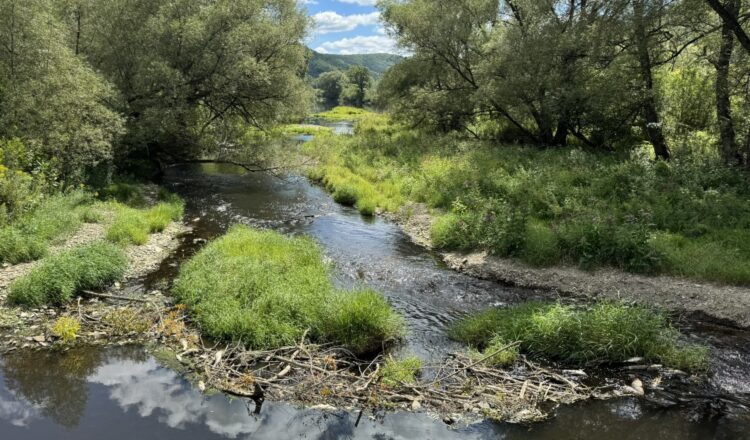A first-hand account of the Ischua Creek environmental disaster
By Clayton “Tiger” Hulin, RN
When I moved to Franklinville, I traded the broad sweep of the Genesee River Valley, the Green Jade of a River that had always meant home, for a smaller, quieter treasure. The Ischua Valley and its slender creek became my gem.
In early 2024, after a fall left me with a broken shoulder and more stillness than I knew what to do with, I found myself drawn to its banks. There, where the willows lean low and the water runs cool, I watched trout breach the surface and leave behind rings of bubbles before diving back to their depths. It is not an exaggeration to say that this creek helped me heal. When my arm failed me, words became my only tool, and Ischua’s steady rhythm gave me a voice to write.
That is why this loss feels personal. Would you stand on the bank and watch a friend suffer from afar, or would you step in to help?
What They Are Calling “Organic Wastewater”
In the official statements, what entered Ischua Creek is being described as organic wastewater. At first, that phrase might sound harmless. What is more “organic” than water? But in chemistry, organic does not mean “clean” or “natural.” It means carbon-based.
That definition sweeps in the good, such as milk sugars, proteins, and fats, and the harsh, such as sanitizers, detergents, caustics, and acids. A cheese plant runs on all of it.
So when the New York State Department of Environmental Conservation (DEC) says “organic wastewater,” they are not talking about some wholesome farm rinse. They are talking about a mix of compounds that do not belong in a living stream.
What Comes Out of a Cheese Plant
Cheese processing wastewater can include:
- Milk sugars (lactose) and proteins that microbes devour, stripping oxygen out of the water as they break it down.
- Fats that coat surfaces and choke aquatic life.
- Caustic cleaners like sodium hydroxide, used to dissolve proteins and grease from stainless steel pipes.
- Acid rinses like nitric or phosphoric acid, used to remove mineral scale.
- Sanitizers such as chlorine, peracetic acid, or quaternary ammonium compounds, designed to kill bacteria but just as deadly to fish and frogs.
- Detergents and surfactants, which create foam and interfere with the way fish breathe through their gills.
On paper, many of these are “organic.” In practice, they form a toxic cocktail.
Why the Fish Died
What happened in Ischua Creek was not a mystery. Dump enough organic material into a stream and the microbes bloom. As they feed, they consume the oxygen fish depend on. Add in traces of caustics, acids, and disinfectants, and you are not just starving fish of oxygen, you are poisoning them outright. That is why so many species, from trout to crayfish, went belly-up in just days.

Sidebar: Why the Creek Still Stinks
When organic waste first hits the water, oxygen-loving microbes rush in to feed. They burn through the dissolved oxygen so quickly that fish and insects suffocate. Once the oxygen is gone, a different crowd of microbes takes over, the kind that thrive without air. These anaerobic bacteria keep breaking down the waste, but instead of leaving the water clean, they release gases like methane and hydrogen sulfide. That is why, days after the fish kill, you can stand on a bridge and smell the creek giving off rot. It is not just dead fish you smell, it is the biology of oxygen collapse.
Rumor and Reality
One neighbor said she heard it was “deoxygenated water” that caused the kill. That is not quite right. While I think this is possible, if we believe the DEC, the effluents released into the creek would have sucked the oxygen out as microbes fed on them. The end result looks the same to a fish, suffocation, but the mechanism matters if we want to prevent this from happening again.
Out of respect for my neighbors, I want to acknowledge that their questions are fair. They wanted an answer about the exact spill, the how, and the whys. I find them to be kinder and more magnanimous than myself, and their concern comes from a place of care for this valley. That deserves both honesty and accountability.
Where We Stand Now
The DEC has stepped in. The Great Lakes Cheese facility has been told to stop its discharges, tighten up its wastewater treatment, and improve monitoring. Drinking water has not shown contamination so far, but private wells are being tested. Citizens have been warned to stay out of the creek downstream of Franklinville.
That is the official story. But we, the community, have the right to ask sharper questions: What exactly was in that water? Which compounds were tested for? Were the cleaning chemicals measured, or just the milk sugars?
On Sunday, August 31, 2025, I met two DEC Officers on the creek bank. They declined my request to take their picture, but there they were on a holiday weekend, running their drone and doing their job. Our mutual concern for the avian and aquatic life was clear in our conversation. So too was their commitment to the institutions and infrastructure that protect our waterways. Thank you, gentlemen.
I also spent that day along the creek. The flies were beginning to rise in a louder hum, mingling with the gentle roll of the water. At most of the bridges the smell of off-gassing fish was unmistakable. The nose cannot help but know the truth.
A Nurse’s Note
I have worked long enough in health care to know that language matters. If a nurse charted “organic discharge” without explaining what it meant, you would call it sloppy, maybe even negligent. Regulators owe us the same honesty. “Organic wastewater” is not harmless. It is milk sugars, proteins, fats, caustics, acids, disinfectants, and detergents. It is the reason a living creek now looks like a morgue.
And if we let the words get soft, the water will never get clean.
There is an old verse in Exodus that comes to mind: “And the fish that was in the river died, and the river stank, and the Egyptians could not drink of the water of the river” (Exodus 7:21). The people of Ischua Creek are not living through something new, but something ancient in its familiarity. When rivers die and fish float belly up, it is a warning. The question for us is the same as it was for them. Will we harden our hearts, or will we finally listen to what the river is saying?
Clay “Tiger” Hulin is a Franklinville NY based writer and Registered Nurse. You can reach him anytime at claymation_88@yahoo.com







